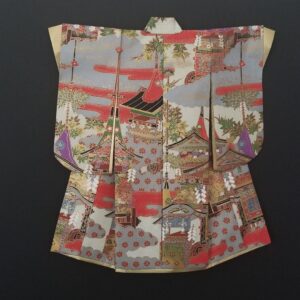A series of chance encounters during her frequent trips to Japan as a flight attendant led Karen O’Hanlon to the art of folding Japanese paper. She was immediately drawn in by the history and tradition that surrounded the artform and the papers, as well as the precision required in working with such a delicate medium.
While there are many popular items one can learn to fold in origami, Karen narrowed her focus to the paper kimono. Studying with a master artisan, Karen spent five years perfecting her folding technique.
She now uses her expertise to craft paper kimonos from chiyogami, chirimen-gami and yuzen paper, which allow her to replicate the types of designs and styles one would see on silk kimonos. From the bright, bold patterns of chiyogami to the silken textures of the chirimen-gami, the papers she selects are all part of the process of creating realistic kimonos on a miniature scale.
Karen shares more about what drew her to this art form decades ago and why she’s so passionate about honoring this age-old Japanese tradition.
Why did you choose this medium?
I chose paper as my medium because of the uniqueness of Japanese paper.
As an international flight attendant, I had the privilege of flying to Japan and learning about Japanese paper arts. I always made gifts for my family and friends. I was fascinated by the dolls I found in a restaurant showcase. The owner of the restaurant would close her restaurant at night and teach flight attendants how to make many things using Japanese paper. I started with the dolls. I was convinced by my sensei, Yuriko Kodama, to concentrate on the kimono. It took me five years to perfect the kimono. I framed a kimono and gave it as a gift. That was 25 years ago, and I’ve been creating the kimono ever since.

What challenges you most about this medium?
The biggest challenge I have is keeping my lines straight and my curves smooth and exact as I fold the paper.
One of the papers I use is called chirimen. It is very difficult to find because there are not many Japanese left that still make this paper. They use a special tool called a momidai. The younger generation has no desire to carry on this tradition.
What do you love most about this medium?
My favorite thing about my medium is being able to share with others the history of the Japanese paper. I share this rich history with my collectors by explaining the scene that is represented on the kimono.
Some of the papers have scenes on them that tell a story. A good example is a popular paper that depicts “The Tale of Genji,” which was the first novel ever written in the world. Many times I display the story of the paper next to the particular kimono.
When a collector purchases a piece I give them the information about their kimono explaining which paper was used and the story if it is a kimono with a scene. Most of the papers I use have patterns that date back to the Edo period (1600-1867). At one time, these patterns were on traditional Japanese silk kimonos.

How are you using paper that might be different from most?
The original and current use of the paper is for gift wrapping. Giving of gifts is a very important custom in Japan. But there is only one other person in the United States that was taught by sensei Kodama.

